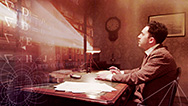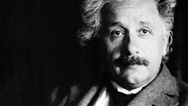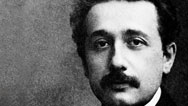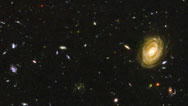Einstein Thought Experiments
- Posted 09.09.97
- NOVA
Albert Einstein famously used thought experiments—experiments carried out in the mind only—to work out complex ideas. Here, watch animations of Einstein chasing a light beam (which helped lead him to his theory of special relativity) and riding an elevator in free-fall (which convinced him that gravity and acceleration are one and the same). Finally, see a visualization of one of the basic concepts of general relativity—that bodies like stars and planets warp the "fabric" of space-time.
Transcript
Einstein Thought Experiments
Posted: September 9, 1997
CHASING A LIGHT BEAM
NARRATOR: Someone watching a car accelerate toward light speed would see something very strange. It would seem as though the car itself was getting shorter, and that time for the person in the car was slowing down. However, you wouldn't see these effects until the car began to approach the speed of light. At 90 percent of the speed of light, the car would appear to shrink to 44 percent of its usual length. This thought experiment answered Einstein's old question about what he would see if he traveled along with a beam of light. He simply couldn't make the trip, for at the speed of light, length would contract to zero, and time would stop.
RIDING AN ELEVATOR IN FREE-FALL
NARRATOR: In one of Einstein's famous thought experiments, he realized that gravity and acceleration appear to be the same phenomenon. Think about what would happen if an elevator suddenly went into a free-fall. The person inside would effectively weigh nothing. Next, imagine that same person in a motionless rocket ship so far from Earth that the force of gravity is practically zero. Just like in the free-falling elevator, he would also weigh nothing. Now, put the rocket in motion. As the rocket speeds up, the passenger's weight increases. To him, it feels just as if gravity had planted his feet firmly on the floor. Einstein realized that the force of gravity is just the acceleration that you feel as you move through space-time.
ORBITING THE SUN IN SPACE-TIME
NARRATOR: If there were nothing in our universe, the fabric of space-time would be flat. But add a mass, and dimples form within it. Smaller objects that approach that large mass will follow the curve in space-time around it. Our nearest star, the sun, has formed such a shape in space-time, and our tiny planet Earth goes along for the ride, staying in orbit around the sun.
Credits
Image
- (animation still)
- © WGBH Educational Foundation
- Animations by
- S. Raciti/© WGBH Educational Foundation
- Narration by
- Lauren Aguirre
- Edited by
- David Levin
Related Links
-

Inside Einstein's Mind
Retrace the thought experiments that inspired his theory on the nature of reality.
-

Einstein's Big Idea
The story behind the world's most famous equation, E = mc2
-

Einstein Revealed
A two-hour special revealing the hidden life of Albert Einstein and tracing the birth of his groundbreaking ideas
-

Relativity and the Cosmos
Physicist Alan Lightman muses on what many consider Einstein's greatest achievement—general relativity.

